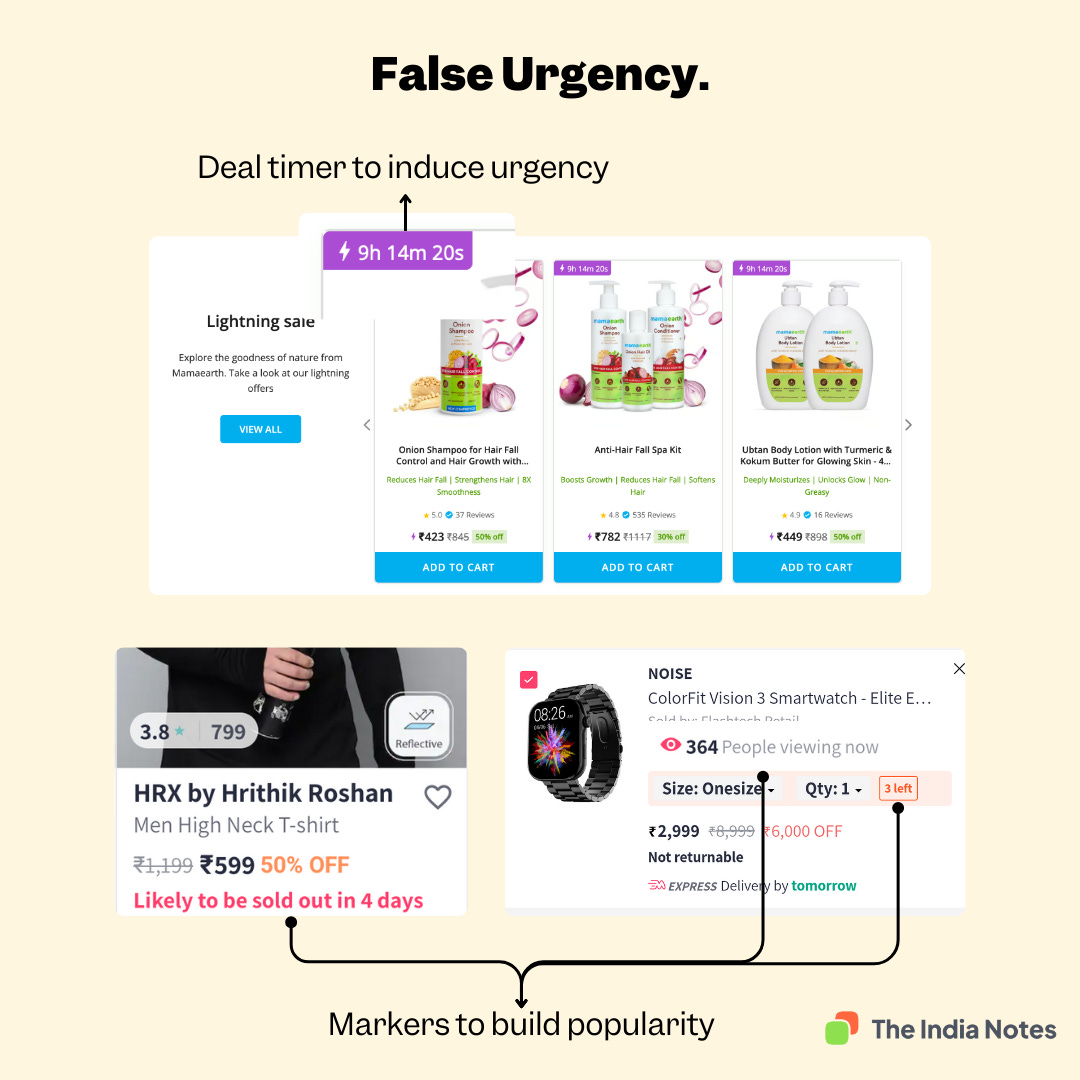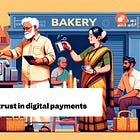India's focus on Dark Patterns
An analysis of the draft guidelines issued by the Ministry of Consumer Affairs.
Mr. S, an employee of the Chennai Municipal Corporation, urgently needed Rs. 2500 for an expense. Influenced by online advertisements promising instant loans without documentation, he downloads a loan app from the Google Play store. During onboarding, he is compelled to share his contacts with the app before securing the loan. A few days later, a representative from the app contacts him via WhatsApp, demanding repayment of Rs. 3500, including Rs. 1000 in interest and penalties. However, the provided payment link turns out invalid. Subsequently, he was asked to pay a fine of Rs.35000 a few days later. When Mr S refused, his friends received a manipulated image featuring his wife and child, taken from his Whatsapp profile picture, accompanied by offensive language. This incident escalates to the point where Mr S reports it to the police, leading to widespread media coverage in Tamil Nadu in 2022.
The above event highlights two significant hurdles in safeguarding the nation's consumer interests. Data sharing and dark patterns. We will delve deeper into the latter.
Table of Contents:
What is a dark pattern?
The draft guidelines
List of dark patterns with examples
How are dark patterns formed?
Challenges of implementing the guidelines
New business models
Dark patterns and data sharing
Conclusion
What is a dark pattern?
Dark patterns are deceptive design strategies employed in digital applications. Companies use these to manipulate consumers into acting in the company's best interest rather than their own. These dark patterns are subtle design and content strategies that influence consumer choices in favour of the company.
The draft guidelines
Numerous global trade and commerce bodies are trying to tackle dark patterns to safeguard consumers. The Indian Government has now aligned itself with the Federal Trade Commission (USA) and the European Union. In September 2023, India introduced draft guidelines that identified ten dark patterns frequently observed in Indian apps and online businesses and invited public feedback.
This article will provide a detailed analysis of the dark patterns mentioned in the draft guidelines, including some examples, and discuss the difficulties in enforcing them.
List of dark patterns with examples
1. False Urgency means falsely stating or implying a sense of urgency or scarcity to mislead a user into making an immediate purchase or taking an immediate action, which may lead to a purchase.
Ever come across alerts like "Only two items remaining!" or “364 individuals are viewing this!” or even a ticking timer that instils a feeling of urgency, compelling you to make a purchase immediately? This is known as false urgency.
2. Basket Sneaking means the inclusion of additional items such as products, services, payments to charity/donation at the time of checkout from a platform without the consent of the user, such that the total amount payable by the user is more than the amount payable for the product(s) and/or service(s) chosen by the user. This may manifest as minor charitable contributions or subscribing to extra services from the platform or its affiliates. Typically, these options are subtly introduced at the final checkout phase, often going unnoticed until the final moments.
Flipkart checkout screenshot courtesy: Rohit Srivatsav on X(Twitter)
3. Confirm Shaming refers to the act of inducing guilt or foolishness in an individual for rejecting a proposition. An example of this is expressing "No, I will take the risk" while refusing travel insurance. This strategy is exploitative and targets your emotional responses."
4. Forced Action refers to the situation where you're compelled to perform an action you hadn't intended to, such as needing to register an account before exploring an app's features. It's akin to the obligation of providing your email address merely to peruse a restaurant's outdoor menu.
5. Subscription Trap includes making it impossible or complex and lengthy to cancel a paid subscription, hiding the cancellation option for a subscription, or forcing a user to provide payment details and/or authorization for auto-debits to avail a free trial.
Have you ever registered for a complimentary trial only to discover that terminating it is extremely difficult? This is known as a subscription trap. It's a cunning strategy employed by applications to make the termination process challenging, such as hiding the cancel option within multiple menus or requiring you to contact customer support to cancel. Broadband service providers commonly use this tactic.
6. Interface Interference means a design element that manipulates the user interface in ways that (a) highlight certain specific information and (b) obscures other relevant information relative to the other information to misdirect a user from taking an action desired by her.
This pertains to the perplexity caused by poorly designed user interfaces. It refers to buttons that are not easily identifiable as such, critical decisions that are not prominently displayed and the design of the 'close' button in online advertisements that resembles the conventional 'sign up' button, and vice versa.
7. Bait and Switch means the practice of advertising a particular outcome based on the user’s action but deceptively serving an alternate outcome. It's akin to spotting a promotional offer for a pizza, only to discover upon arrival that the offer applies only to the smaller size, with the regular size being pricier. This scenario can be compared to one where a room's cost is advertised, but the rates fluctuate once you access the reservation website.
8. Drip Pricing refers to a practice where:
Elements of prices are not revealed upfront or are revealed surreptitiously during the user experience.
A product or service is advertised as free but requires an in-app purchase for continued use.
A user cannot access a paid service unless an additional purchase is made.
Imagine this scenario: you reserve a seemingly affordable accommodation online, but when you reach the final payment stage, service charges, additional expenses, and taxes dramatically increase the total cost. This sudden surge in price at the end is called drip pricing.
9. Disguised Advertisement means posing, masking advertisements as other types of content such as user generated content or new articles or false advertisements. Buttons that lead to pop-ads and similar content are designed to mimic the appearance of standard website buttons, tricking users into clicking on them under false pretences. While mainstream websites typically avoid this tactic due to its negative impact on user trust, many other websites across the internet employ it.
10. Nagging shall mean a dark pattern due to which users face an overload of requests, information, options, or interruptions; unrelated to the intended purchase of goods or services, which disrupts the intended transaction. This refers to the application that persistently prompts you to provide a rating or switch to its premium version. Examples include the incessant advertisements on streaming platforms encouraging a premium subscription, or the continuous alerts from online shopping applications reminding you of items in your shopping cart. It's a nuisance that is universally familiar.
How are dark patterns formed?
Sometimes, dark patterns are deliberately implemented, such as an unregulated lending app coercing users into sharing their contacts for later exploitation. However, these dark patterns are often viewed as a growth hack, manipulating consumer psychology and gradually becoming standard practice. For instance, over the past ten years, e-commerce companies have fostered the belief that online products are generally cheaper than those in physical stores. Consequently, all products now display the original price and a discounted one. This has led to intentionally marking up prices only to slash them to the regular price, creating a perpetual "sale" atmosphere for online purchases.
The compartmentalized functioning of product organizations can also contribute to the emergence of dark patterns. As a digital product expands, each component, such as onboarding, notifications, retention, and checkout, gets its dedicated team to enhance its workflow metrics. If a food tech company's notifications team is tasked with improving the ratio of notification taps to food orders, they might resort to inundating users with a barrage of notifications.
Challenges of implementing the guidelines
As previously discussed, the draft guidelines identify specific dark patterns that startups often call growth hacking to encourage users to engage and transact more with their products. It would not only be difficult to agree on whether all the mentioned patterns are indeed dark, but also challenging to put them into practice. For instance, a dark pattern such as "forced action" could be implemented at the level of the Play Store and App Store, but it would be difficult to enforce or even verify a pattern like “False urgency”. It's not straightforward to confirm if a message like "Last 2 shirts remaining" is valid or not. Even if a company has more stock, the inventory software's audit trail could be manipulated to achieve the desired outcome. How the government will enforce this if approved remains to be seen.
New business models
An advantageous by-product could be the creation of innovative business models. For instance, a unique e-commerce business that prides itself on not adopting any dark patterns could be established. The business's philosophy could serve as a distinguishing factor.
New independent assessment firms could emerge, tasked with periodically scrutinizing the workflows of these apps to assign them an ethical rating and provide suggestions for enhancement.
Conversely, we might anticipate the emergence of advanced growth hackers who assist digital apps in creating an illusion of eschewing dark patterns while still employing them by discovering and exploiting loopholes in their implementation.
Dark patterns and data sharing
Data privacy and dark patterns are often intertwined. Like how inflation can contribute to poverty, these two distinct topics can influence each other. The rise of performance marketing has made data extremely valuable. Information like contacts, social media details, and email addresses can help businesses retain and attract customers. Therefore, collecting data has become a key objective for online companies.
This can lead to dark patterns like forced action, where users must share their contacts to use a service. This shows the link between the two issues. Companies' desire for data is fulfilled through dark patterns, resulting in consumers being overwhelmed with constant marketing campaigns that direct them to certain apps. Some of these apps may then use dark patterns to exploit both unaware and savvy users. This is why efforts by the Government of India to tackle dark patterns are timely.
Conclusion
In the last six years, often referred to as the post-Jio era, the internet and smartphones have become accessible to the common man. As consultants put it, India has leapfrogged. However, the challenge of this rapid advancement is that it can be difficult to differentiate the good from the bad without guidance.
For instance, when buying a saree, a woman can determine its quality simply by touching and feeling it. Unfortunately, until now, there have been no clear parameters to distinguish a good app from a bad one in the digital world. The conversations around dark patterns mark a promising start in this direction.
The relationships we form with digital interfaces represent a massive psychological experiment on humankind. These relationships need to be handled with care to ensure a utopian future.
What do you think of these guidelines? Let us know in the comments
References
India’s draft guidelines on dark patterns
Federal Trade Commission take on Dark Patterns
European Union data protection guidelines
(Fin)
Did you recognize a few dark patterns from your daily life? Share it with your friends and colleagues to see if the did?!❤️😯
If you’re new to The India Notes, check out these latest reads,

















